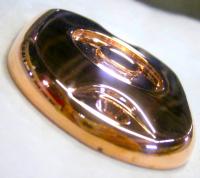
Photo from wikipedia
OBJECTIVE The aim of this preclinical in vivo study was to compare histologically and histomorphometrically osseointegration of dual acid-etched vs. hydrophilic implants. MATERIAL AND METHODS Two pairs of implants (Neodent, Curitiba,… Click to show full abstract
OBJECTIVE The aim of this preclinical in vivo study was to compare histologically and histomorphometrically osseointegration of dual acid-etched vs. hydrophilic implants. MATERIAL AND METHODS Two pairs of implants (Neodent, Curitiba, Brazil), with same macrogeometry but different surface technology (i) dual acid-etched surface (SAE) treatment with hydrochloric and sulfuric acid followed by microwave treatment and insertion in isotonic saline solution to increase hydrophilicity (SAE-HD) (test, n = 12); (ii) dual SAE (control, n = 12) were installed bilaterally in the proximal tibia of six beagle dogs. Histologic and histomorphometric evaluation was performed after 2 and 4 weeks in vivo, on non-decalcified sections. Percentages of bone-to-implant contact (BIC) and bone density (BD) were estimated and tested for significant differences with the Wilcoxon signed-rank test for paired samples (P < 0.05). RESULTS In general, new bone formation along and in contact with the implant surface could be observed irrespective of the experimental group and observation period. Most of the bone was woven but small quantities of lamellar bone, mainly in close proximity to the cortex could also be observed. BIC at 2 weeks was 19.57 ± 13.57 and 20.33 ± 7.99 (P = 0.75), and at 4 weeks was 42.80 ± 14.48 and 40.25 ± 9.45 (P = 0.65) for SAE-HD and SAE implants respectively. BD at 2 weeks was 24.85 ± 16.31 and 25.66 ± 8.59 (P = 0.35) and at 4 weeks 44.13 ± 6.46 and 40.13 ± 6.46 (P = 0.25) for SAE-HD and SAE implants respectively. CONCLUSION Bone-to-implant contact and BD increased with time in both SAE-HD and SAE implants. No significant differences were observed between the two different implant surfaces for any of the evaluated parameters and at any observation time-point.
Journal Title: Clinical Oral Implants Research
Year Published: 2017
Link to full text (if available)
Share on Social Media: Sign Up to like & get
recommendations!